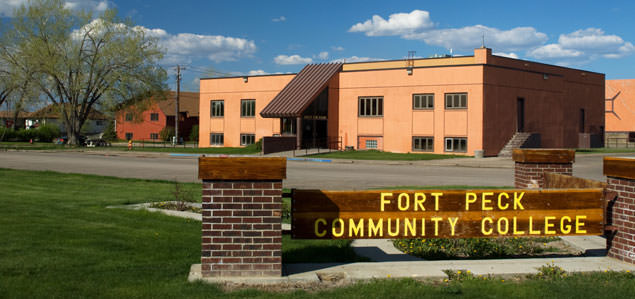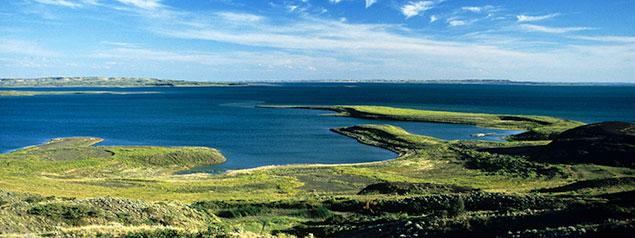
Fort Peck Reservation-
The Assiniboine and Sioux Nations
It stretches across the low hills and sprawling prairie of the northeast quadrant of Missouri River Country. Millions of bison once migrated through the landscape, historic trails crisscrossed it and Lewis and Clark walked the shores of the big Missouri River and its southern perimeter ... Montana's second largest reservation, home to the Assiniboine and Sioux nations.... The Fort Peck Indian Reservation.
In the early 1600s, Europeans displaced the ancestors of the Assiniboine and Sioux from the east coast. By the end of the century, the Sioux had migrated west and south to central Minnesota. Known as a large and powerful nation, they were comprised of seven bands, or council fires, all of who spoke a language of Siouan descent. These seven divisions evolved into what are known today as three different language groups: the Dakotas (Santee Sioux), the Nakotas (Yankton and Yanktonai Sioux) and the Lakotas (Teton Sioux). The people of the Fort Peck Reservation belong to the Nakota band.
At about the time they arrived in Minnesota, one band of the tribe split into two: the Yankton who traveled west across the northern plains and the Yanktonai who went north to Canada.
The word ass-ni-pwan means "stone Sioux," referring to the Assiniboine method of cooking food with hot stones and boiling water.
Historical notes show the Assiniboine are a branch of the Canadian sect, having broken away sometime in the 1600s to form a distinct tribe. The name Assiniboine traces back to their Siouan ancestry. The word ass-ni-pwan means "stone Sioux," referring to the Assiniboine method of cooking food with hot stones and boiling water. Like the Sioux, sometime during the 17th century, the Assiniboine split into two groups; one staying north in the Canadian woods and the other roaming south to hunt bison on the Great Plains. In the mid 1700s, the southern group divided again with one contingent leaving for the Missouri River Valley region and taking on the name Lower Assiniboine.
Not only had the tribe split several times, thereby decreasing the population, but smallpox decimated the size of the Assiniboines by nearly two-thirds making them vulnerable to other Plains tribes. Unable to defend their hunting grounds, they welcomed the terms of the so called 1851 Fort Laramie Treaty that "set aside" specific lands for each of the Indian Nations inhabiting what would become Montana and Wyoming.
The Lower Assiniboine eventually joined the Yanktonai Sioux who had migrated to northeastern Montana.
Today, nearly 6,200 Sioux and Assiniboine live on the approximately 110-mile long and 40-mile wide Fort Peck Reservation.
Wolf Point, once a frontier outpost, and now home to the Wolf Point Wildhorse Stampede, Montana's oldest pro rodeo, is on the Reservation. The town of Poplar is the center for tribal activities and hosts The Assiniboine and Sioux Cultural Center and Museum.
Reservation life is rich with traditions. Powwows are held to renew and strengthen family and friendships as well as to celebrate tribal culture. A myriad of dance styles retrace ancestral customs and celebrate their close connection to the land. These Indian family gatherings not only feature dancing and drumming, but traditional foods and story telling are shared. Visitors are welcome.
The Fort Peck Reservation is home to many fascinating artifacts and historical places including tipi rings, buffalo jumps, and sacred sites. If you are interested in seeing them, contact the tribal office (406-768- 5156) as sensitivity issues and tribal customs must be considered and respected.






